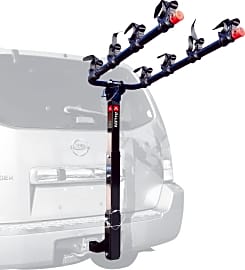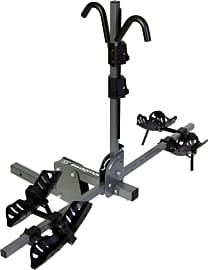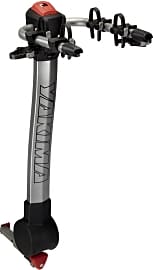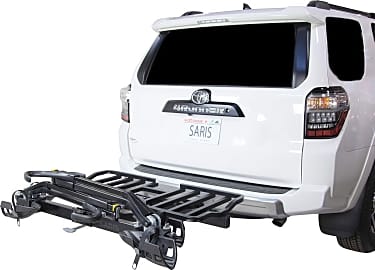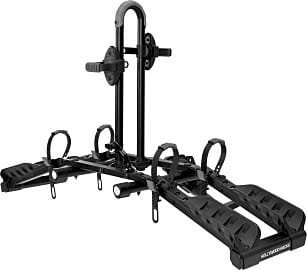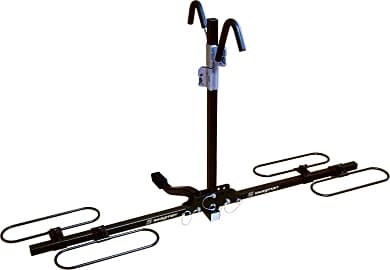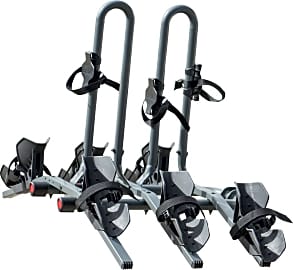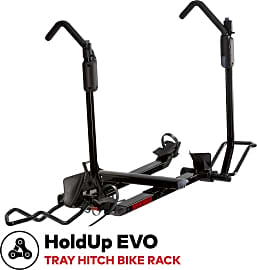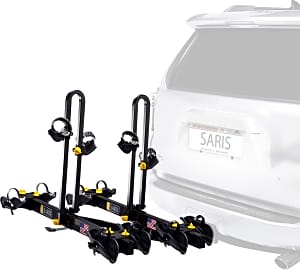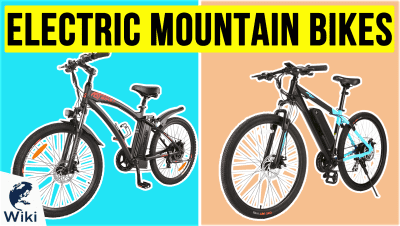The 10 Best Hitch Bike Racks

This wiki has been updated 42 times since it was first published in August of 2015. Ready to take your cycling adventures farther afield? Our selection of hitch mount bike racks includes many that attach easily to the back of your car or truck and can accommodate cycles of all types, from beach cruisers to fat bikes to high-end carbon fiber models. They come in capacities appropriate for individuals, couples and families, and will have you enjoying new scenery in no time. When users buy our independently chosen editorial picks, we may earn commissions to help fund the Wiki.
Editor's Notes
September 21, 2020:
When it comes to purchasing a bike rack for your vehicle, the most important thing to most buyers is stability. They want something that isn't going to wobble much, if at all, and which will reliably hold their bikes as they drive over various terrains. As can be expected then, that was our first and foremost priority when selecting the models for our list. With that out of the way, we were then able to focus on other things, such as ease of assembly and installation, versatility in the types of bikes they could carry, weight capacity for each individual bike, and theft deterrence, among others.
When it comes to theft deterrence of your precious cargo, you will want to choose a model that locks in place over the frame of your bike, such as the Thule T2 Pro XT, Swagman Dispatch, Saris Superclamp Plus Cargo, and Yakima HoldUp Evo. For most others you will have to buy a lock separately, which we highly recommend if you plan on leaving your bike on the back of a vehicle for any period of time when you aren't actively in it.
The Saris Superclamp Plus Cargo and Yakima HoldUp Evo deserve mention again for certain features they offer that others don't. In the case of the former, it is an integrated cargo area for all that other gear you are carrying. In the case of the latter, it is the ability to carry a wide range of bikes, from e-bikes to boost hubs to fat tires without the need for any additional purchases.
If you have a fat tire bike, you may want to purchase a rack that can carry it without the need to buy separate wheel trays, which the Thule T2 Pro XT, Allen Sports Deluxe, Yakima Ridgeback, and Yakima HoldUp Evo can all do.
Some may not realize that you can attach any old rack to the back of an RV or fifth wheel trailer. This is because it is significantly rougher back there than at the back of the vehicle. If this is your planned application, you will want to check out the Swagman Dispatch.
Whichever model you do end up choosing, make sure that you follow the manufacturer's recommended guidelines regarding weight capacity, as overloading a rack can cause it to fail.
August 17, 2019:
Hitch bike racks are an ideal way to transport your ride because they are solid, stable, and easy to load. They are, of course, heavier than hanging-style or roof-mount racks, so if you plan to remove and remount the rack often, you'll want to pay attention to weight.
You should also know the weight of the bike or bikes you're planning to carry, and make sure the rack you choose is rated to handle that much weight. They can generally hold anywhere from 35 pounds per bike on the low end to 65 per bike for the heftier options.
In this update, we evaluated products based on quality, usability, and reputation among users. Our selections are not the cheapest you can find, but when you've spent a lot of money on bicycles, you don't want to skimp on a rack that puts your investment at risk. It makes sense to get a sturdy, high-quality rack to haul them. That's why we promoted the Kuat NV 2.0 to one of our top slots. We like its sturdiness and its integrated cables and locks that will help keep your ride secure.
Hitching A Ride
The racks themselves grab your bikes with simple clamp mechanisms for the wheels or the crossbars, further reducing your workload and preventing the bikes from slipping.
There's a beautiful animated series from Japan about a group of young artists trying to find their individual voices as they navigate the waters of art school and fledgling love. In the series, a character named Takemoto takes off on his bicycle after a tragic event causes him to question his direction in life, and he rides the often mountainous 1,500 kilometers to Japan's northernmost point in search of himself.
Now, I know that the journey was the most important part here, but come on, Takemoto, wouldn't it have just been easier to hitch that bike onto one of these nice racks and drive up there? You certainly would have sweat a lot less, and the cycling option isn't even available on Google maps.
There are a lot of ways of transporting a bicycle. You could break it down and ship it, you could sell it and buy another if you're moving, you could ride it like our wacky friend Takemoto did, or you could strap it to a rack and let your vehicle do all the work.
A bike rack will allow you to transport one to four bikes on average, and there should be no question as to their security. Many racks come with straps and locks intended to keep the bikes in place even well above highway speeds, and you can use additional bungee cords or ratchets for added security if you're nervous about it.
What makes a hitch rack superior to its standard cousin, however, is the ease and security you gain from the use of the hitch itself. Other bike racks require you to fumble around with thin nylon straps, asking you to rely on your car's unique infrastructure and on the knot tying skills you barely remember from boy scouts. If any one of those points should prove weak, you could not only lose the bikes you're carrying, but you could cause quite the car accident behind you in the process.
A hitch bike rack secures itself in the hitch bar on the backside of your vehicle, installing in just a coupe of minutes with a level of stability you won't get from regular bike racks. Using the hitch also means that you won't see a dozen loose ends from nylon knots flying all over the place in your rear view. The racks themselves grab your bikes with simple clamp mechanisms for the wheels or the crossbars, further reducing your workload and preventing the bikes from slipping.
Where Are You Going With That Thing?
Just by looking at the bike racks on our list, it's clear that there are some differences. The shapes alone imply different capacities and methods for adhering your bikes to the rack, but it might not be entirely clear what those differences mean to you.
On the other hand, if you take shorter, more frequent trips with your bikes, ease of installation is paramount.
As you peruse the options we've laid out before you, keep a few questions in mind about the kind of bike travel you intend. For example, if you're picking up a rack for a single move with the intention of using it in future journeys that have a lot of space between them, you might prioritize the security of the bikes over ease of installation. Traveling a great distance requires the most possible security for your bikes, as vibrations in the road can cause a loosening of all kinds of knots and screws and bolts if you go with one of the quicker options.
On the other hand, if you take shorter, more frequent trips with your bikes, ease of installation is paramount. The quality of day's journey into a mountain for a little trail biking is dependent on the amount of time you get in the mountains, and if you find yourself spending an inordinate portion of your morning setting up your bike rack, you could lose precious light on your one day off.
Finally, there are questions of capacity and visibility. If you're the only biker in your family, and you own the only bike, you probably don't need a hitch rack with a four-bike capacity. If you're planning on growing your family or introducing the kids to biking as they age, investing in a larger rack is a good idea.
When that rack is installed, it runs the risk of blocking at least some portion of your view out the back window. Take a good look at the construction of your vehicle from the hitch up. Measure it, if you must. Then, take a look at the designs and the specs on these racks to figure out where the bikes you intend to carry will fall in your field of vision. As in riding the bikes, safety in carrying them is paramount.
Take The Bike Higher
If you were to ask most people whether the bicycle or the automobile came first on a timeline of our getting around, most people would erroneously assume the bike had a big head start. In reality, the two methods of transportation grew up side-by-side, as the first gasoline-powered car came out a little less than a year after the first pedal-powered bike debuted in 1863.
Still, the mobility of the individual at this point in history was limited.
At the time, the design of the bicycle was crude and uncomfortable enough that its popularity didn't catch on until the metallurgy of the day gave manufacturers the tools to make bikes more like today's models, keeping bikes out of the hands of the many until the 1890s.
Still, the mobility of the individual at this point in history was limited. A person might make one or two major moves in his or her lifetime, negating any need to travel great distances with a bike. What's more, the sporting aspect of bicycling was, for the time, confined to track and street races, without mountain biking on the horizon until the tires and suspension systems of the design could be improved.
Eventually, after the Second World War, the explosion of personal wealth in the American middle class led to an abundance of leisure activities, including mountain biking in the 1970s, as well as a marked increase in the movement of individuals. The first racks to assist bike owners in these movements were mostly homemade until increased interest in mountain biking in the 1980s led companies like Saris and Thule to invest in designs to carry bikes into the altitudes.


